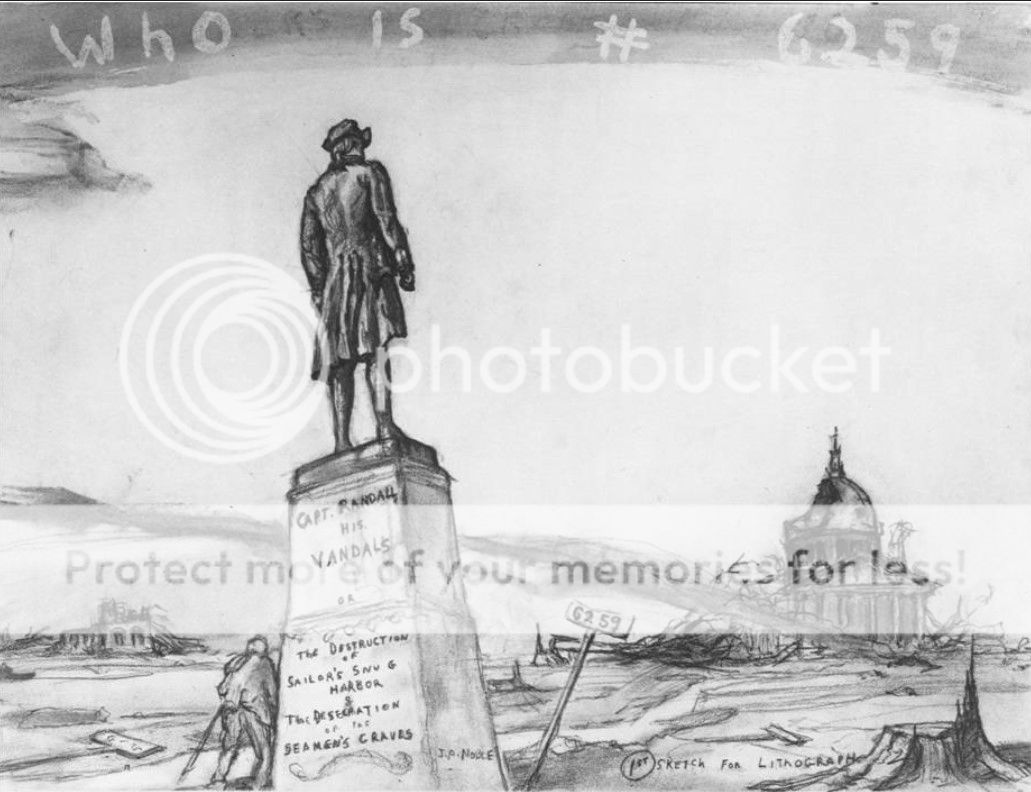_(edited)_7E7D1336-0DD5-41A2-A729-A7543713C4C1.jpeg)
Sailors' Snug Harbor had been a self-sufficient organization from its earliest days. In the 1950s that would change. The first to go was the farm animals and the barns. Next, the Hospital Building and the Sanitarium built in the 1890s were demolished (Barry, 142). The Harbor trustees were preparing the Harbor land to be updated into a modern facility that would meet the needs of the Sailors more efficiently. Afterall the trustees of Sailors Snug Harbor were not running a cultural center or a museum; they were responsible for the comfort and wellbeing of the decrepit sailors.
However, when the Randall Memorial church was torn down on Staten Island, a replica of St Paul's Cathedral in London, the people of Staten Island became very concerned and worried about what else would be torn down on Sailors' Snug Harbor Land (Barry, 145).

Randall and his Vandals, Nobel Maritime Collection
This led to an outcry to the New York Preservation Committee. The Preservation Committee stated that "Buildings "A" through "F" of Sailors' Snug Harbor were determined to have "a special character, special historical and aesthetic interest and value as part of the development, heritage, and cultural characteristics of New York City"(New York Preservation Society). The buildings were also designed to be "notable example[s] of the Greek Revival Period. (New York Preservation Society).

Greek Revival Buildings - New York Public Library Digital Collection.
In 1965, the five Greek Revival Buildings A, B, C, D, and E, were designated as New York City Landmarks as was the chapel at Sailors' Snug Harbor. The Municipal Art Society, of which Jackie Onassis was a director, played a role in obtaining the landmark designation for the Greek Revival buildings. All but one was slated for demolition (Dembart). Jackie Onassis was an old hand at preservation and revitalization (White House Historical Association). When she was the first lady, she worked to restore and return artifacts that were a part of the White house's collection. Mrs. Kennedy and Mr. Henry du Pont were able to hire the first curator for the White House, and Congress passed Public Law 87-286, which made the White House a Museum. The White House's Fine Arts, as well as the architecture in the rooms, became protected (White House Historical Association).. This increased the donations of furniture and decorative arts to the White Houses' Collection (White House Historical Association).

The Chapel, Sailors' Snug Harbor - New York Public Library Digital Collection
Less than a month after the buildings at Sailors' Snug Harbor were designated as New York City Landmarks; the Snug Harbor trustees sued to negate the designation (New York Preservation Society).. The Trustees argued that the dormitories were obsolete, and the forced preservation would affect Sailors' Snug Harbor charitable purpose of providing housing for retired sailors (New York Preservation Society). The trustees would eventually lose the suit. The New York Times would state that "preservation is not only in the public interest, but is a decisive factor in the quality of the environment” (New York Preservation Society). The Mayor of New York, John Lindsay, settled any further legal action by offering to buy the buildings and the land at Snug Harbor on Staten Island, in the name of the City of New York on February 2, 1971. Sailors' Snug Harbor would be designated a Staten Island New York Museum(New York Preservation Society). Sailor Snug Harbor trustees would build a new sailor home at Sea level North Carolina but retain ownership over the Snug Harbor Cemetery.
In New Haven, Connecticut, in December of 1812, all burials on the New Haven Green ceased. The new burials took place in the Grove Street Cemetery. The New Haven Green Burial ground was neglected, and the result was that the Burial Ground became foul and unsightly (Blake, 254). On June 26, 1821, the gravestones were removed, and the ground was leveled (Blake, 254). The only remaining evidence of those long dead today is the saved gravestones in the Grove Street Cemetery.
Sailors' Snug Harbor shares a similar fate to the New Haven Burial Ground. The stone monuments that were placed to mark the graves of the deceased seamen were removed, and iron markers were placed in their stead. These iron plaques decayed, and today there are very few monuments that mark a seaman's grave. Only approximations can be made to determine the location of a deceased seaman. This can be accomplished with the cemetery map and Thomas Melville's manner of describing where a seaman's grave lies in the Monkey Hill Cemetery. This is marked on the death certificate of the seamen found at Suny Maritime archives. Melville's method, of describing the position of a grave continued with future Governors. Today with no interments since the late 1970s, the Monkey Hill Cemetery looks like a park, with a deteriorating fence surrounding it.
_14D8A789-269D-4CCC-9E52-F636BB2A8B23.jpeg)
_01F0C28C-FBAA-44AA-BF8C-8F1843E5A176.jpeg)
Mitchell, Robert. Sailors' Snug Harbor Cemetery or Monkey Hill, Picture Digital, December 30, 2021.